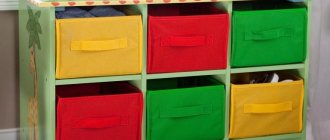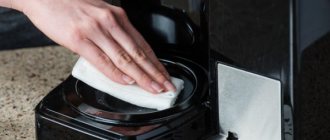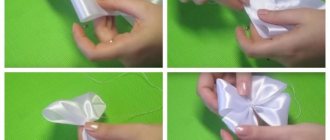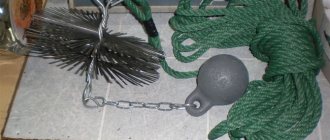Mechanical cleaning using a cable
What to do in a situation where boiling water combined with a plunger cannot clear blockages in the sewer?
In this case, the surest way would be a cable. Care should be taken, as this device can easily damage plastic pipes and cause them to leak. To make a cable yourself, you will need a metal flexible wire. Then one end of the cable must be bent to form a small hook. It will be convenient for them to catch debris stuck in the drain hole and pull it out. As for the second end, a piece of fabric should be tied to it, making a handle.
You need to carefully insert the cable inside the drain pipe and try to push through the accumulated dirt. For better cleaning, you can rotate the device clockwise. Then you need to pull out the cable with the remaining debris.
To completely remove the clog, you need to flush the drain with a strong stream of boiling water from the shower or tap. This method is one of the most effective today. This is what most plumbers use.
Plastic bottle
The toilet drain is also cleaned using the same principle. Since the hole diameter is wider here, you need to use a larger container. A 2 liter plastic bottle is perfect for this. It is enough to cut off the bottom and insert this end into the drain. When the bottle is completely filled with water, screw the cap on. Then the plastic is compressed and sharply pulled out of the hole.
How to get rid of a clog without a plunger
The main operating principle of a plunger is to push an air plug into the pipe. Crashing into the water, the air bubble creates a hydraulic shock, which, as a result, pushes the blockage to a wider area of the sewer. You can get rid of minor blockages in the sink and bathtub without any equipment at all, literally with your bare hands. Use your palm like a plunger - cover the drain with your bent palm, and then sharply straighten it, pushing air into the pipe. Do this several times and the clog will go away.
If you need to “break through” the toilet, you can build something like a plunger from a stick and an unnecessary rag. Wind the fabric onto the stick so that the winding fits snugly into the hole in the toilet. Then lower the resulting structure into the drain, and then sharply pull it out. You will get the same water hammer effect as when using the original tool.
How to make a plunger from a plastic bottle
If a stick and an unnecessary rag are not nearby, you can build a kind of plunger with your own hands from a plastic bottle. Take a two-liter container and cut off the bottom completely. Then insert the bottle into the toilet flush hole with the cut bottom down. Wait until the water fills the bottle and screw the cap on the neck. Now sharply squeeze the plastic and pull the container out of the drain. The water that comes out of it forms the same water hammer that pushes the blockage deeper into the sewer.
What to make a plunger for cleaning a sink
If your sink or bathtub drain is clogged, a plastic bottle will not work as a cleaning tool. Its diameter is much larger than the size of the drain hole, which means it will not be possible to create a sufficient vacuum of air with its help. How to make a plunger suitable for such an occasion? We take a milk or juice tetrapack and cut off a corner so that the cut is approximately equal in diameter to the plum. Using the cut corner, we insert the bag into the drain hole and hit it well to squeeze the air collected inside into the pipe. If it doesn’t work the first time, straighten the tetra pack and repeat the operation.
Palm
Oddly enough, you can literally clean the drain with your bare hands without the help of any objects. This method is suitable when there is a blockage in the sink. It is enough to press your palm tightly with a hump to the drain hole and then sharply straighten it.
This method creates the same vacuum effect as a plunger, forcing a stream of water downwards.
Boiling water is a simple and effective helper
First you need to establish the scale of the problem. If the blockage is observed in only one area, then the problem can be solved quickly. If the water does not drain in all the pipes, you need to call specialists - you can’t handle this on your own.
Boiling water can only be used in situations where metal pipes will be cleaned. The cleaning principle is simple. You need to heat about 4-5 liters of water and slowly pour it down the drain. If the blockage is not removed on the first try, repeat all steps. Cleaning will be much more effective if you additionally use a plunger. Boiling water will not solve the problem if water has accumulated in the pipes and appears outside, collecting near the drain. You need to understand that boiling water simply cannot reach the blockage. When using a plunger, you need to be extremely careful not to get burned by the hot liquid.
How to clean plastic pipes in the bathroom? In such a situation, you cannot use boiling water. The liquid should be moderately hot. Washing powder is added to it. Just a few tablespoons per liter of water is enough
The liquid is poured down the drain slowly and carefully
Precautionary measures
The ingredients included in Krot are not safe for humans. Their contact with the skin or mucous membranes provokes a chemical burn, and contact with the eyes leads to loss of vision. The caustic hydrogen sulfide released during the chemical reaction causes suffocation.
Compliance with passive safety measures will help avoid health problems:
- Carry out work only with protective rubber gloves.
- It is better to wear a mask or respirator on your face.
- It is recommended to protect your eyes with special glasses.
If troubles cannot be avoided, you must:
- Wash areas in contact with the chemical with a weak solution of boric acid and sufficient running water. If necessary, seek help from a doctor.
- If poisoned, drink at least 2 liters of water and immediately go to the clinic.
How to replace a plunger
A plunger at home can be replaced with:
The temperature of the water used will vary depending on the material from which the pipes are made.
It has an aggressive composition and easily corrodes substances that hold together debris that impedes the free flow of water. The same chemical compositions are suitable for the bathtub and sink; “Mole” is considered the most popular.
This is one of the most budget-friendly items that will definitely come in handy around the house and can easily replace a plunger.
Surely everyone has experienced a situation where the water in the bathroom, sink or toilet stagnates and does not go away, and there is no time to wait for a plumber. In such cases, a plunger usually helps. However, such utensils are not always at hand, so the question arises of what can replace a plunger at home.
Various home methods will help to cope with this problem, which require means available to everyone.
What are the methods for clearing clogs?
Blockages can be cleared using three main methods.
- Thermal - when hot water with various additives is used.
- Chemical – based on the use of household chemicals, which are sold in almost all stores.
- Mechanical - to eliminate it, special devices are used that are inserted into the drain hole.
Each method is as effective as possible. The result is influenced by the type and location of the blockage.
Thermal cleaning
This method will require products that every housewife has in her kitchen. If you need to clean metal pipes, you can use boiled water; if you need to clean plastic pipes, it is better for the liquid to be at room temperature.
You need to pour water into the drain hole and wait one hour; if the blockage remains, you need to use salt, soda and washing powder. They should also be poured into the drain, then pour water on top. After a couple of hours, rinse the drain with hot water.
You can also heat baking soda in a frying pan, then mix it with water and pour it down the drain. After a couple of hours, not a trace of the blockage will remain.
If using just baking soda doesn't help, you can add vinegar. To do this, pour a glass of soda into the drain, then pour vinegar on top. A chemical reaction will begin that will corrode any salt or fat deposits. Afterwards, the drains should be rinsed with regular warm water.
Chemical options
The modern market offers many types of household chemicals that can be used if you urgently need to remove the blockage.
The choice of chemicals and its quantity depends on the degree of blockage of the drain. Typically, such products just need to be poured or poured into the drain hole and wait a few minutes.
Mechanical methods
Such cleaning methods are based on the use of various special tools. Can be used:
- plumbing cable,
- metal hook,
- plastic bottle,
- vacuum cleaner,
- a floor rag.
Also, if the design allows, it can simply be disassembled and the debris that creates the blockage can be easily removed from it. If you use a floor cloth, then you need to choose a material that will absorb moisture as much as possible and keep its voluminous shape.
You can make a plastic rope out of a bottle, which can be used to easily clean and remove debris from the drain, or use it as a plunger (not the most effective method).
If you urgently need to find a way to replace a plunger at home, you can use any of the above methods. Each of them is highly effective, but only when used correctly and taking into account the degree of clogged drain.
Cleaning methods
So what are they? If the drain in the bathtub is clogged and there is standing water, but there is no way to call a plumber, then you can try to clean the drain yourself using the following methods:
- thermal: use of hot water;
- chemical: the blockage is removed using certain compounds;
- mechanical: special devices are used to solve the problem.
The choice of method depends primarily on the type and location of the blockage.
Best answers
Natasha Lipovetskaya:
Removing a clogged bathtub begins with pumping it with a plunger. In this case, there should be no air suction under the bowl of the plunger, however, at the top edge of the bath there is a mesh overflow cover, which is connected to the outlet by a pipeline through a tee. If you put the van-ace on the outlet of a bathtub, in which there is some water blocking the bowl of the plunger, and start pumping, you will hear air entering and exiting through the overflow. Therefore, for a better fit to the surface of the bathtub, you should close the overflow cover with the bowl of the second plunger soaked in water. Consequently, to pump the bathtub you need to have two plungers and work together. If the pumping is successful, open the tap so that the water flushes the pipes, and repeat the pumping again. If the faucets have a flexible hose, then apply its shower net to the outlet for a few minutes and open the hot water. Instead of a plunger, you can use a damp cloth large enough to cover the overflow cap. In this case, air leaks cannot be avoided.
If the sewer pipes under the bathroom are very clogged, pumping with plungers does not give any results. In this case, turn out the plug that closes the cleaning in the sewer pipe to drain water from the bath. Insert the cable into the cleaning direction in the direction of water flowing out of the bath and move it back and forth. To make work easier, open the hot water tap above the bathtub. The water will lubricate the cable and at the same time remove some of the blockage. In this case, many difficulties may arise. In homes built in the last couple of decades, the drain pipe from the bathtub is generally located above the floor. The elbow of the washbasin siphon is also lowered into it. If the plug does not come off or there is no cleaning at all, disassemble the siphon under the washbasin, take out the elbow and insert a cable into the resulting hole in the pipe. After removing the blockage and installing the siphon, you should better caulk the annular gap between the elbow and the hole in the pipe, since the next time there is a blockage and the bath is overfilled, water will flow into this gap.
Papa Bear:
if the blockage is not large, then you can try to break through it with your palms, the principle is the same as with a plunger - you stack one on top of the other and then do a “heart massage” on the sink. Sometimes it helps to remove the shower head, lower the hose into the drain and turn the hot water on full blast.
Vladimir Gorbylev:
My first remedy is to remove the tube from the hose of the vacuum cleaner, insert it into the drain hole of the sink, lightly seal the annular gap with the girth of my palm and blow strongly into the tube. It punches in one go!
But if the toilet is clogged, it’s more difficult, you can’t blow it, you need a punching cable.
Ksenia:
wrap the rag in a bag and pump it with it
Elena Shelekhova:
I used the option of a rag wrapped in a bag. And it worked. I was happy, it was so easy to deal with the clog in the kitchen sink (the water was no longer draining and was standing in the sink).
Dan:
If anyone has an old (Soviet) set for a flush cistern lying around, there is a rubber “plug” there, you insert a screwdriver into it, for example, and go ahead, I’ll tell you, it breaks through just as well as a plunger
Oleg Kutsenko:
Same problem. I took a 5 liter bottle, filled it with water, put the neck in the drain and pressed hard. Water under strong pressure cleaned everything instantly
Measures to prevent contamination in the bath
D»Ã ÃÂþóþ ÃÂÃÂþñàÿÃÂõôþÃÂòÃÂðÃÂøÃÂàà·Ã°Ã³ÃÂÃÂ÷ýõýøõ ò ÃÂûøòõ ÃÂðúþòø ýàøûø òðýýÃÂ, ýõþñÃÂþô øüþ ÃÂôõûøÃÂàòÃÂõüàÿÃÂþÃÂøûðàºÃÂøÃÂõÃÂúøü ÿÃÂþÃÂõôÃÂÃÂðü. ÃÂàòÃÂÿþûýõýøõ ýõ ÿþÃÂÃÂõñÃÂõà üýþóþ òÃÂõüõýø, ð ÃÂÃÂõôÃÂÃÂòð, à All rights reserved. , ýðùôÃÂÃÂÃÂàò úðà¶Ã´Ã¾Ã¼ ôþüõ.
çÃÂþñàòþôþÿÃÂþòþôýÃÂõ ÃÂÃÂÃÂñàýõ ÷ðóÃÂÃÂ÷ýÃÂûøÃÂàþÃÂÃÂþôðüø, ø ýõ ÿþÃÂòøûþÃÂàÃÂøÃÂÃÂðÃÂø ø, úþóôð òþôð ÿûþÃÂþ ÃÂÃÂþôøÃÂ, ýõþñÃÂþôøüþ ÷ðúÃÂÃÂòðÃÂàÃÂûøòà VALUE ûÃÂýÃÂüø ÃÂõÃÂúðüø ôûà÷ðÃÂøÃÂÃÂ. › õàüøýøüø÷øÃÂþòðÃÂàÿþÿðôðÃà½Ã¸Ãµ ÃÂðÃÂÃÂøÃÂõú ÿøÃÂø ø ôÃÂÃÂóøàþÃÂóðýøÃÂõÃÂúøà þÃÂÃÂþôþò ò ÃÂûøò.
- ðÃÂÃÂòþÃÂÃÂÂàýðúþÿøòÃÂøùÃÂàüàÃÂþàÃÂûõôÃÂõàýõ ÃÂõöõ ÃÂð÷ð ò üàµÃÂÃÂÃÂ. The ºÃ¾Ã³Ã´Ã° ÷ðÃÂþÃÂàõÃÂõ ýõ ÃÂûøÃÂúþü à òþôõ ø òþôð › ÂøÃÂ. âðúðàÿÃÂþÃÂõôÃÂÃÂð ÃÂñõÃÂõöõàþà þñÃÂð÷þòðýøàÿÃÂþñþú. ÃÂÃÂþòþôøÃÂàõõ üþöýþ àÿþüþà VALUE ð÷øýõ (ÃÂÃÂþÃÂ, âøÃÂõàâÃÂÃÂñþ ภÃÂ. ô.).
- GALA µ ÿõÿðÃÂðÃÂÃÂ,àüþöõàþñÃÂÃÂýÃÂù ÿà ôûàÃÂÃÂøÃÂúø. ÃÂûàÿÃÂþÃÂøûðúÃÂøúø ÷ðÃÂþÃÂþò ý õþñÃÂþôøüþ ÷ðúÃÂÃÂòðÃÂàÃÂûøòýà VALUE ¸Ã½Ã ÃÂð÷ ò 4âÂÂ5 üõÃÂÃÂÃÂõò. › › õù òþôþù. ÃÂþ ÿÃÂþÃÂõÃÂÃÂòøø 5 üøýÃÂàÿÃÂþÃ±Ãºà ¸ ýÃÂöýþ òÃÂýÃÂÃÂÃÂ. ÃÂÃÂþàÃÂÿþÃÂþñ ÃÂðúöõ ÿþüþöõàà VALUE ¿Ã°ÃÂð ø÷ ÃÂûø òð.
- ÃÂûàÃÂþóþ ÃÂÃÂþñà÷ðÃÂþÃÂàôþûóþ à ÿþÃÂòûÃÂûøÃÂÃÂ, üþöýþ ÿÃÂþûøààÃÂûøòýþõ þÃÂòõÃÂÃÂÃÂøõ úøÿ ÃÂÃÂúþü ø÷ ÃÂðùýøúð. › »ÃµÃ´ÃÂõàò ÃÂõÃÂõýøõ 2âÂÂ3 üøýÃÂÃÂ.
What happened and how to deal with it
The cause of the blockage is the accumulation of fat on the internal walls of the sewer, soap and powder deposits, as well as hair and fibers of various fabrics are added here. Where did all this come from, you ask? The fact is that the inner surface of the pipes is not perfectly smooth, this is especially typical for old cast iron structures.
These are the reasons why the drain is clogged
Plastic is also susceptible to similar contamination, although to a lesser extent. Here, plaque formation begins at the joints of pipes and O-rings. In such conditions, it is enough for a plaque to appear in one place, and the remaining particles will cling to it, reducing the internal cross-section of the pipe until they clog it completely. This is the reason why the pipes in the bathroom are clogged. What to do in this case?
There are three ways to solve the problem:
- using excess pressure;
- chemical method;
- mechanical method.
Let's look at each method in more detail.
Chemistry can handle any blockage
What to do if a clogged pipe cannot be cleaned either with a plunger or a cable, and even cleaning the siphon does not give the expected results? In this case, you have to resort to chemicals. With the help of chemicals, you can clear any blockage without putting in the slightest effort.
When choosing a pipe cleaner, you should take into account all the active components of the selected product. Some of them are so aggressive that their use is only possible in cast iron pipes. And some can be used exclusively for plastic pipelines.
Very important!!! To work with any chemical, maximum caution and protective equipment is required. To achieve the desired result, you need to pour the amount of product indicated on the label into the drain hole and wait until it does its job. Then open the warm water and clean the sewer pipe using water to remove the blockage and the filled product
Then open the warm water and clean the sewer pipe using water to remove the blockage and the filled product
To achieve the desired result, you need to pour the amount of product indicated on the label into the drain hole and wait until it does its job. Then open the warm water and clean the sewer pipe using water to remove the blockage and the filled product.
When working with chemicals, follow safety precautions. Avoid contact with skin or mucous membranes. You should also be careful not to get such products on chrome surfaces, otherwise it can not only clean the pipe, but also remove the chrome coating from the faucet.
Chemical preparations are also used for preventive purposes; small doses of the substance, diluted with water, are poured into the drain hole and wait a few minutes for the drug to begin to act. Then rinse with running warm water. This procedure is carried out at least once a month.
Sources
- https://o4istote.ru/sovety-po-domu/kak-sdelat-vantuz/
- https://fb.ru/article/396709/kak-prochistit-trubyi-v-vannoy-sposobyi-i-sredstva-zasor-v-vannoy
- https://moemchistim.com/vanna/kak-prochistit-zasor-v-vannoy-bez-pomoschi-specialista.html
- https://pochistim.com/2017/04/chem-i-kak-prochistit-zasor-v-vannoy-effektivnyie-sposobyi-i-sredstva/
- https://vseotrube.ru/kanalizatsiya/zasor-v-vannoj
- https://kvarremontnik.ru/zabilas-vanna-kak-prochistit-v-domashnikh-usloviyakh/
- https://OUborke.ru/kak-prochistit-zasor-v-vannoy
- https://remontonly.ru/kak-pochistit-sliv-v-vannoj.html
- https://santex1.ru/kak-prochistit-sliv-v-vannoj-podruchnymi-sredstvami.html
- https://vanna-prosto.ru/chistka-i-uborka/kak-prochistit-zasor-v-vannoj/
- https://odomah.org/1041904764515519448/reshenie-izvechnoj-problemy-kak-legko-prochistit-zasor-v-vannoj-i-rakovine/
- https://abvseptik.ru/kanalizatsiya/chem-rastvorit-volosy-v-kanalizatsii.html
- https://sandizain.ru/uxod-i-sanitariya/zasory-i-prochistka/kak-samostoyatelno-ustranit-zasor-v-vannoj.html
Best answers
Brazen Rush of the Soul:
Make rotational translational movements with the plunger in relation to the drain hole)))))))!
IT'S ME:
Vantus!
Oldman:
Depending on the type of pipe, the remedies range from steel cable and mole liquid to mild laxatives.
Sanya:
and I mean the same thing, plunger, plunger, and plunger again... or a man under the sink...
VadBuhr:
Yong understood, but it’s great!! and what does a clogged pipe have to do with food and cooking??
Sveta Shubina:
You unscrew the pipe, remove the garbage (don’t forget to put a bucket) and screw it back in, and everything is ok. Good luck in this difficult work.
User deleted:
Flood your neighbors! they will help!!!
Yulia Usacheva:
Pour soda into the drain hole - 2 table. spoons, pour vinegar on top, and a violent cleansing reaction will begin. It is necessary to cover the hole a little, and then rinse well with running water.
Vyacheslav Danilov:
I have a piece of oxygen hose and a piece of steel wire is twisted at the end, I take it out of the sink “Gusak” and insert it there with a rotational movement until the end and then insert the other end and the faucet and turn on the hot water to the fullest extent, at this time I push the hose back and forth, well. fuck... xya and then gradually pull it out, then I fill the kitchen sink full of hot water and in the bathroom the hose from the washing machine inserts the bathtub drain, also hot water all the way through and at the same time my wife pulls out the plug in the kitchen from the sink and all this under pressure washes away what I picked up in pipe You can wrap a cloth around the end with a hose from a washing machine and insert it into the drain of a bathtub or sink and rinse it off under strong pressure of hot water, although the effect is less than in the first option, that’s all, I wish you good luck.
Cleaning device made from car parts
How to build a plunger from improvised materials? Car enthusiasts probably know that a CV joint boot can be used for these purposes. This is a kind of cover for the front axle shaft. It is usually made of silicone or rubber. The shape of the anther is similar to the bowl of a plunger. Due to its relief and softness, it works no worse than a real plunger. The only modification that will need to be made before using this device is the handle for convenience. There is a suitable hole at the top of the boot. To unclog a bathtub or sink drain with it, simply plug it with a wine stopper. You should not glue the handle to such a homemade plunger, otherwise you will not be able to rinse the device after use.
What to do if there is no plunger
A fairly common problem is clogged sewer pipes in an apartment, which in turn are very convenient to remove with the help of a plunger. Any plunger works on the principle of creating short-term pressure in the pipe, due to which a breakdown of a weak plug occurs. Of course, it doesn’t always help, and it’s a simple situation when it’s simply not at hand, but a blockage has formed and needs to be eliminated. If you don’t have a plunger, you can use several options; let’s look at each of them in more detail.
- Use the cable. As a cable, you can use a regular car cable, if the plug is located not far away, or a coil specially designed for this purpose with an appropriate length that will reach even as far as China. But unfortunately, it is also not always possible to find it, especially in your apartment.
- You can use household chemicals, namely products for dissolving fatty growths, if they were the cause of the formation of a blockage in the pipe. If the cause of the traffic jam is household dirt, then chemicals are unlikely to help you. Also, when using cleaning products, use only formulations specifically designed for these purposes and under no circumstances pour various alkalis and acids into the pipe - this can lead to an explosion as a result of the interaction of alkalis with vegetable and animal fat, or at best you can damage plastic pipes.
What to do if there is nothing suitable for this at hand? Let's look at children's toys or a regular first aid kit. Do you have a medicine bulb or a small rubber ball? If there is, then great, we take them in our hands and cut off the nose of the pear, and in the case of a ball, we make a small hole in it. We apply them to the hole in the drain pipe in the sink and press sharply, that is, we work with it according to the principle of a plunger.
You can try tapping the pipes with a light object. Depending on the material from which the plumbing fixtures in your apartment are made, strike lightly, but sharply and for as long as possible. If the blockage is not severe, then there is a chance to rip it off. Also, do not forget to combine different options to achieve the greatest effect.
If the pipes are made of soft material, such as metal-plastic, then you can try bending them slightly, thereby stirring up the blockage and it may move.
In principle, these are the main methods that will help clear the blockage in the absence of a plunger. In all other options, if the plug cannot be moved, it makes sense to contact a plumber.
How to use a plunger and what to replace it with step by step instructions
Almost every Russian has an ordinary plunger in his household closet, among the jars and bottles filled with “miracle” remedies. By the way, it is this simple design that will save your sink, bathtub or toilet from clogging, and you from the need to call a plumber. To become a home sewer expert, all you need to know is how to properly use a plunger and put your knowledge into practice.
Operating principle. A standard plunger is a cup-shaped valve made of thick rubber on a plastic or wooden handle. The operation of the device can be compared to a pump: when you pull the handle, water “flows” to the valve, and with it the garbage plug is squeezed out. In addition, the water hammer effect is triggered: due to changes in pressure, water rushes into the drain at high speed, pushing through the blockage.
Most often, pipes become clogged at narrowing points, at turns (corners) and joints. A plunger is not only an effective, but also a safe device. Unlike chemicals that can corrode pipes from the inside, a plunger is completely harmless.
Types of plungers. Depending on the tasks assigned to the device, the following variations are possible:
- A plunger with a cup-shaped nozzle, which copes with small blockages, and costs just a penny.
- An improved model with a cone-shaped nozzle (to provide better adhesion to the drain), designed for more severe blockages.
- A powerful pneumatic plunger helps to cope with completely clogged drains and pipes, working like a pump. The configuration of such devices may vary (depending on the manufacturer).
Step-by-step instructions for using a sewer plunger
- Place the plunger as tightly as possible against the drain hole.
- As a rule, water “stands” in clogged plumbing fixtures. If it is not enough to completely cover the plunger nozzle (and therefore create the required pressure), add the required amount.
- If the nozzle does not “stick”, lubricate the edges with Vaseline.
- Without moving or moving the plunger, apply firm pressure to the handle several times. The “sucking” sound is a sign that you are doing everything right. To clean a toilet or bathtub with a plunger, several “approaches” of 3-5 strong pushes are enough.
- After you have gotten rid of the garbage plug, clear the hole of any floating debris and run hot water over the pipes for 5-10 minutes. If the toilet is clogged, flush the water several times and pour a bucket of hot water down the drain.
How can I replace a plunger?
It happens that a clog has already formed in the sink, but there is no plunger at hand. In this case, do not rush to call a plumber: look in the closet, perhaps there is something there to replace the plunger. The main thing is to create a pressure difference, simulating the operation of a plunger.
It is worth saying that such methods and means are suitable for removing only small blockages.
Composition of the cleaning product
The active components of the “Mole” cleaner, regardless of the form of release, are alkalis, which are responsible for dissolving fats:
- Sodium hydroxide (caustic soda or caustic soda), the concentration of which is about 40 - 60%.
- Potassium hydroxide in a concentration of 5 – 10%.
The percentage of active ingredients determines the effectiveness of the drug against blockages. As a rule, cleaners labeled “Turbo” / “Tornado” / “Strengthened” / “Ultra” (see photo) effectively cope with blockages of almost any degree of complexity.
In addition to alkalis, the list of chemical ingredients invariably includes:
- Modified ethylenediaminetetraacetic acid (5 - 10%), softening water and softening solid organic inclusions.
- Non-ionized surfactants (surfactants) in concentrations up to 10%, activating a chemical reaction.
- Distilled water (5 - 25% - in liquid and gel preparations).
Some varieties of “Mole” contain flavorings that ultimately do not affect the cleaning result.
Mechanical methods
Make at least ten sharp downward movements, as if pressing a plunger and lifting it by the handle. In this case, the rubber should not come off the hole. This vacuum cleaning will help remove contamination. If it didn’t clean well the first time, you should run hot water and then use the plunger again.
However, it is impossible to create a vacuum in the bathroom. Therefore, the algorithm of actions there should be slightly different:
- plug the hole for pouring water with a stopper;
- Lubricate the rubber of the plunger with Vaseline and press it to the drain hole;
- make as sharp movements as possible downwards and.
When cleaning bathroom pipes, the water overflow hole must be tightly closed. To do this, you can ask an assistant to hold the second plunger on it.
Causes of the problem
If there is a blockage in the bathroom, water will not pass through the hole. It will flow back out along with the dirt. Before you understand how to clean bathroom pipes, you must first determine the cause of the blockage.
Such a nuisance arises due to the following circumstances:
- Lack of preventive measures. Gradually, dirt accumulated in the pipe, but no one looked after it or cleared the drain in time, which led to a blockage.
- The pipes have become unusable. They became loose and growths appeared on them.
- There is a foreign object in the sewer that prevents grease and dirt from passing through the pipe. Such an object, for example, could be a stone.
- Much depends on the material, because blockages often appear in cast iron pipes, while such troubles rarely happen with plastic products.
- When installing the sewer system, the pipes were installed incorrectly, at a slight slope.
- One of the family members dropped an object, a rag, or waste into the sewer pipe. Often, small children can push a construction piece or something else into the drain hole.
Preventive measures
Without a doubt, the best thing in dealing with clogs is preventive measures. Careful operation will at least allow you to use cleaning agents and forced pipe cleaning less often.
What to pay attention to
Do not throw foreign objects into the drain. Moreover, this category also includes toilet paper, handkerchiefs, cotton swabs, and, of course, personal hygiene products. Simply equip the toilet with a trash can with a lid. If you notice something in the drain, such as air freshener that has come off the rim, try to remove it immediately. Don't expect to be able to just wash the plastic away. It will most likely get stuck somewhere in the pipe and give you drainage problems. Some housewives pour leftover food, be it liquid or even main courses, into the toilet
Under no circumstances should you do this! Fat and solid waste gradually form a dense layer, which you will subsequently spend a lot of time and effort removing. If there are small children in the house, keep an eye on them and teach them the rules of careful use of plumbing fixtures so that the child does not throw markers, books and other toys into the drains. Special situation: renovation. To prevent construction dust, sand and concrete from clogging the ducts, be sure to cover the furniture with film. Periodically clean the drain with disinfectants and solvents, carry out preventive maintenance
But when working with them, strictly follow the instructions so as not to damage the pipes. Clean the toilet itself weekly: inside and out. Old pipes clog more often than new ones because much more debris accumulates on the loose surface. Replacing pipes sometimes becomes the only possible and correct solution in the fight against clogged drains.











